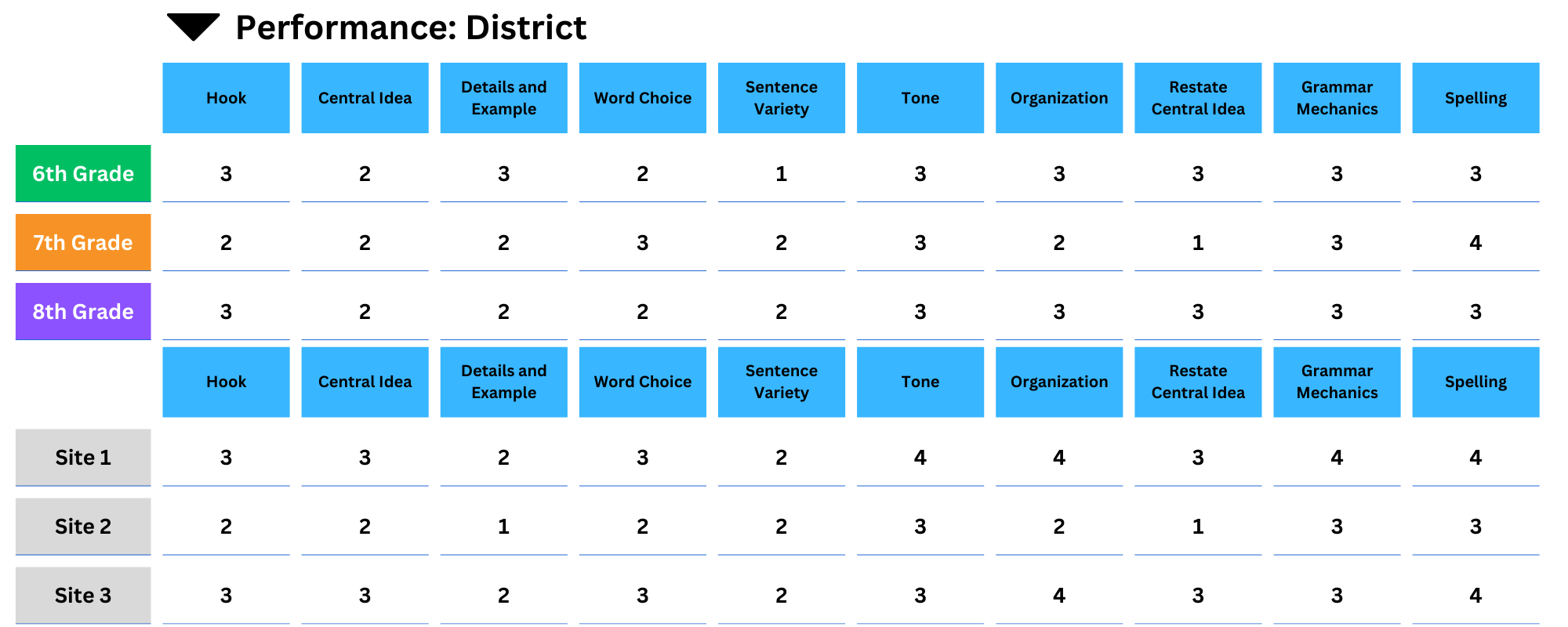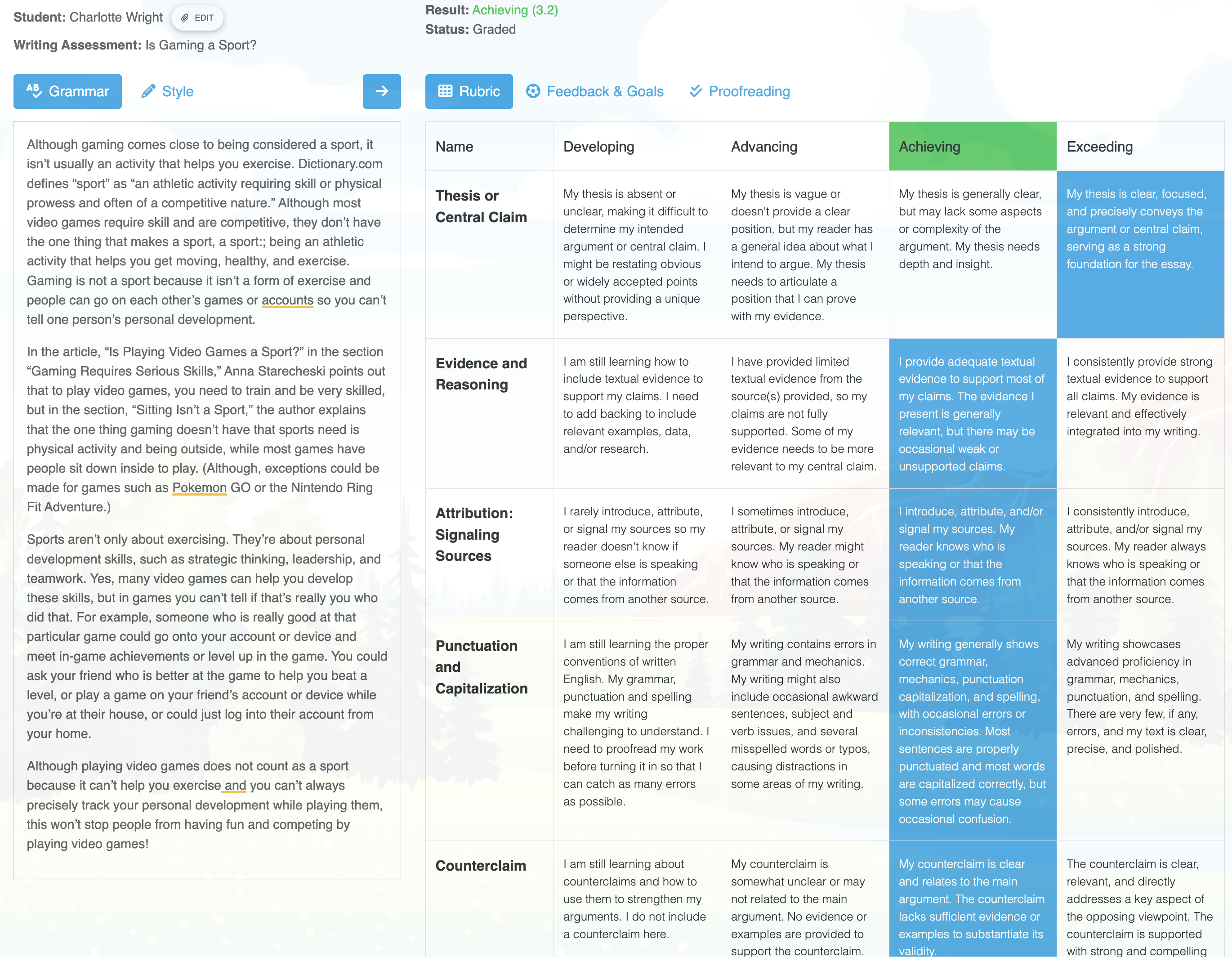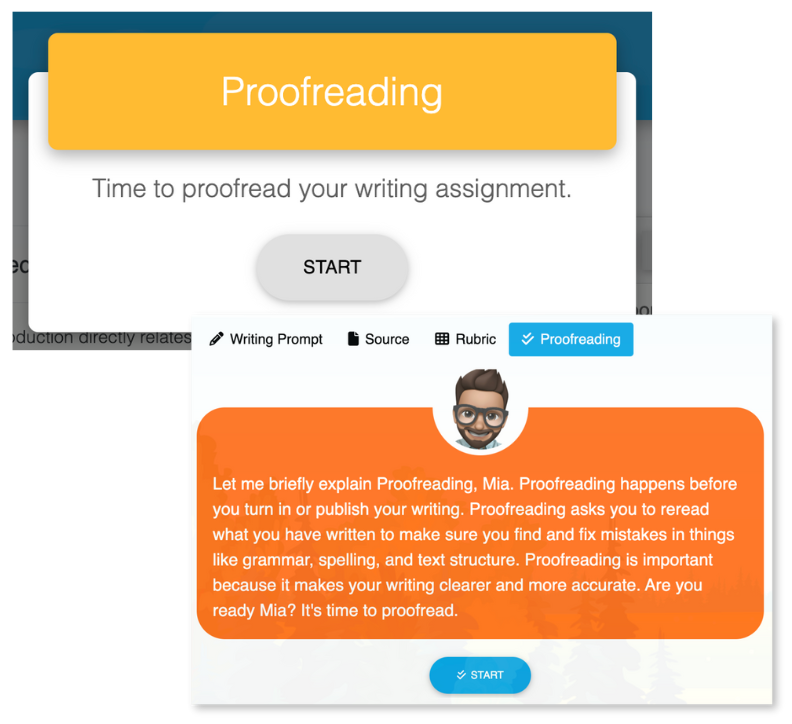Why Do We Need Writing Assessments?
Measure Writing Standards
Recent advancements in technology has made it possible for us to auto-grade writing and measure writing standards. We can grade short responses or lengthier essays and report on how students are doing with argument, informative, and narrative writing.
- implement existing assessments through our platform and get immediate results.
- choose an argument, informative, or narrative assessment from our assessment library.
- assign baseline and benchmark assessments multiple times a year.
- measure how students are doing with text-dependent tasks and analysis.
- deliver writing tasks that look like state assessments to ensure students get familiar with the format.
- build rubrics that evaluate 10 standards and prerequisite skills to better understand what students know and still need to learn.


Centralized Assessment Platform
Effortlessly and effectively facilitate writing assessments across a school and district from one platform grades 3-12.
- create grade-level assessments that can be shared to all sites in your district.
- easily facilitate writing assessments across grade levels.
- review district-wide data all in one place.
- share data with families through our parent portal.
- monitor where students are in the writing process.
- predict who in the district will pass state writing exams and who still needs help.
Differentiated Support
Students learn differently and need different tools to help them meet our standards and expectations. Our online writing assessments are designed for the diverse learners in your classrooms.
- embed universal tools like a language dictionary, digital notepad, word count, text to speech, highlighting, and expandable passages and items.
- assign designated supports like translation tools written at a students grade-level and feedback in easier English.
- ensure students turn in their best work with our automated Proofreader that checks for paragraphs, quotations, word count, and more.
- remove distracting backgrounds and imagery and create passive screens that offer fewer distractions.


Shield Against AI
Detecting AI generated writing is impossible despite what other companies promise. However, there are things you can do to prevent students from turning in AI generated writing if you have the right platform to protect against it. We are here to help.
- ensure students cannot copy and paste writing from AI writing tools.
- track students on the platform and get notifications if students are idle or leave to other websites.
- make it even more difficult to introduce AI writing by asking students to store all personal technology during the assessment.
Rethinking Grading!

"As a teacher, this is making me rethink how I have traditionally graded writing. This program helped me look at writing in a more equitable and objective way. It matched the rubric expectations, what was actually taught, with student work. This levels the playing field because it does not compare writing in a subjective way; it analyzes each piece independently against my lesson objectives. I enjoyed conferencing with my students and felt that the goals and "next steps" offered were logical and attainable." - Kathy, CA
Create the Assessment
When your district is ready to assign an assessment, a Literacy Geek Curriculum Specialist will work with your team to create assessments for your schools. You can...
- build a new assessment,
- use current district assessments, or
- select one of our assessments from our Writing Assessment Library.


Assign the Assessment
Once your assessments are created, your leadership team will want to notify your schools. Individual teachers can select the assessment from one of our platforms (Comprehension Engine 3-5, Quindew 6-8, and Literacy Chops 9-12) and assign it to their classes.
When students are ready to write, students can easily view the assignment and start writing. Students can write over multiple days by clicking "Save for Later" or complete the writing assessment in one class period.
Monitoring the Process
Classroom teachers control each step in the process through our "Status" options. When teachers are ready to assign the assessment, they change the Status from "Ready" to "Start Writing." This opens the assessment so students can start writing.
When students are finished writing, the classroom teacher can review their students' writing. Teachers select "Release Grades" when they are ready to show students their scores and personalized feedback.


Get Instant Data
As soon as students submit their writing for evaluation, results will be ready. In fact, our evaluation takes approximately 40 seconds to score the writing with detailed feedback. Schools and districts will be able to easily see how many students are meeting and exceeding standards as well as how many students are needing more support.
The data will automatically be categorized by a few key metrics.
- District wide results
- School wide results
- Grade level results
- Teacher/class results
Leading the Writing Revolution!
Real-Time Data
With our AI language model, we deliver timely feedback on students' writing skills. This immediate feedback is more effective in helping students grow as writers.
Track Progress
We ensure educators can track individual student progress over time so that teachers can facilitate targeted interventions and personalized instruction.
Feedback & Goals
Our personalized feedback engages students in higher-level thinking as they evaluate their strengths and work toward achieving specific writing goals.
Targeted Instruction
With our Insight Data, teachers can easily analyze results, identify gaps, review student goals and clearly understand where to go with writing instruction.
Equity and Fairness
Our process mitigates potential bias and subjectivity, allowing for more equitable evaluations and reducing disparities among students.
Teachers as Coaches
When teachers have access to authentic writing data, they can spend more time coaching and developing powerful writing lessons and less time evaluating!